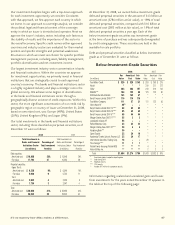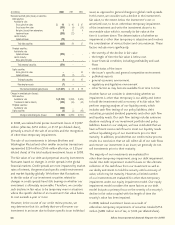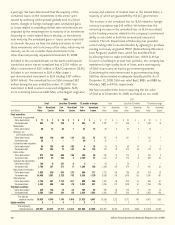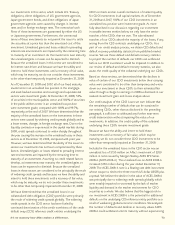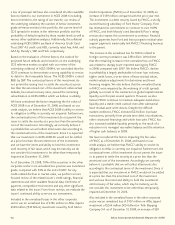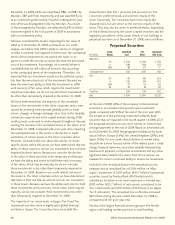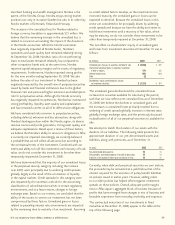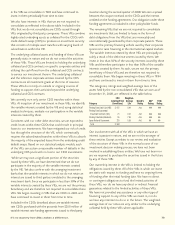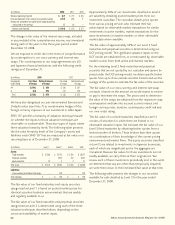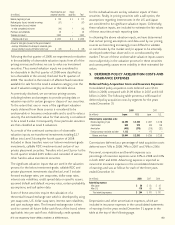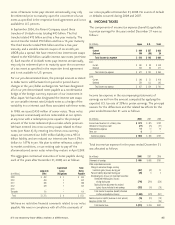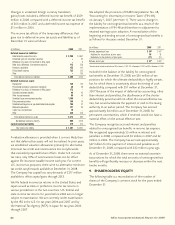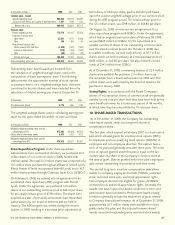Aflac 2008 Annual Report Download - page 81
Download and view the complete annual report
Please find page 81 of the 2008 Aflac annual report below. You can navigate through the pages in the report by either clicking on the pages listed below, or by using the keyword search tool below to find specific information within the annual report.
77
It’s no mystery how Aflac makes a difference.
merchant banking and wealth management. Nordea is the
parent of the Nordea Group. Nordea enjoys strong market
positions not only in its native Sweden but also in its other key
Nordic markets of Denmark, Finland and Norway.
The increase in the unrealized loss for Nordea related to
foreign currency translation is approximately $21 million. We
believe that the remaining increase in the unrealized loss is
related to concerns surrounding the impact of the downturn
in the Nordic economies. While the Nordic economies
have negatively impacted all Nordic banks, Nordea’s
operations and asset quality have remained relatively strong.
At September 30, 2008, Nordea’s ratio of non-performing
loans to total assets remained relatively low compared to
other competitor banks and, at the same time, Nordea
reported capital adequacy margins well in excess of regulatory
requirements. Furthermore, Nordea reported strong profits
for the nine months ending September 30, 2008. We also
believe the value of our investment in Nordea has been
negatively impacted by the overall view of perpetual securities
issued by banks and financial institutions due to the global
financial crisis and perceived higher extension and redemption
risk for perpetual securities. Although the Nordic economy
has negatively impacted its operations, Nordea has maintained
strong profitability, liquidity, asset quality and capitalization
and has remained current on all of its debt service obligations.
We have considered risks common to perpetual securities,
including deferral, extension and loss absorption, along with
Nordea’s leading position within the Nordic region, its diverse
revenue sources and profit generation, strong asset quality, and
adequate capitalization. Based upon a review of these factors,
we believe that Nordea’s ability to service its obligation to Aflac
is currently not impaired. Accordingly, we currently believe it
is probable that we will collect all amounts due according to
the contractual terms of the investment. Combined with our
intent and ability to hold this investment until recovery of book
value, we do not consider this investment to be other-than-
temporarily impaired at December 31, 2008.
We have determined that the majority of our unrealized losses
in the perpetual security category, including the increase
over 2007, were principally due to widening credit spreads
globally largely as the result of the contraction of liquidity
in the capital markets. Credit spreads for this category were
also impacted by the uncertain outlook for the accounting
classification of subordinated securities in certain regulatory
environments, and to a lesser extent, changes in foreign
exchange rates. Based on our reviews, we concluded that the
ability of the issuers to service our investment has not been
compromised by these factors. Unrealized gains or losses
related to prevailing interest rate environments are impacted
by the remaining time to maturity of an investment. Assuming
no credit related factors develop, as the investments near
economic maturity, the unrealized gains or losses can be
expected to diminish. Because the unrealized losses in this
sector are considered to be principally driven by widening
credit spreads and because we have the ability and intent to
hold these investments until a recovery of fair value, which
may be maturity, we do not consider these investments to be
other-than-temporarily impaired at December 31, 2008.
The net effect on shareholders’ equity of unrealized gains
and losses from investment securities at December 31 was as
follows:
(In millions) 2008 2007
Unrealized gains (losses) on securities available for sale $ (2,046) $ 941
Unamortized unrealized gains on securities transferred
to held to maturity 179 343
Deferred income taxes 659 (410)
Other (3) –
Shareholders’ equity, unrealized gains (losses)
on investment securities $ (1,211) $ 874
The unrealized gains declined and the unrealized losses
increased on securities available for sale during the period,
such that we now reflect a net unrealized loss as of December
31, 2008. We believe the declines in unrealized gains and
the increases in unrealized losses primarily resulted from a
widening of credit spreads globally, increases in interest rates
globally, foreign exchange rates, and the previously discussed
reclassification of all of our perpetual securities to available for
sale.
We attempt to match the duration of our assets with the
duration of our liabilities. The following table presents the
approximate duration of our yen-denominated assets and
liabilities, along with premiums, as of December 31.
(In years) 2008 2007
Yen-denominated debt securities 12 13
Policy benefits and related expenses to be paid in future years 14 14
Premiums to be received in future years on policies in force 10 10
Currently, when debt and perpetual securities we own mature,
the proceeds may be reinvested at a yield below that of the
interest required for the accretion of policy benefit liabilities
on policies issued in earlier years. However, adding riders
to our older policies has helped offset negative investment
spreads on these policies. Overall, adequate profit margins
exist in Aflac Japan’s aggregate block of business because of
profits that have emerged from changes in mix of business and
favorable experience from mortality, morbidity and expenses.
The contractual maturities of our investments in fixed
maturities at December 31, 2008, appear in the table at the
top of the following page.


